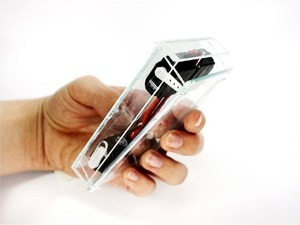Embodied Design and Dynamic Affordances
In the movie After Earth, Kitai, the protagonist, finds a white rod in the wreckage of his space ship. Picking it up, Kitai demonstrates how multiple rods can extrude out of both its ends, much like the previously discussed relief style displays. However, instead of displaying information, these rods take on the form of various weapons or tools (Figure 3). The shape change here is not used to represent information, rather, similar to a swiss army knife, the shape change allows the tool to take on multiple functions.
Changing the shape of a device to change its affordances is a theme often explored in HCI, particular in respect to Organic User Interfaces (OUI). Examples include devices such as PaperFold [2] or Snaplet [4]. Snaplet is a portable device which, when wrapped around the wrist adopts the functions one would expect of a smartwatch. If rolled out on a table, Snaplet allows users to interact with it much like they would with a notepad. If shaped into a curvature fitting the face, Snaplet transforms into a phone.
Other research has focussed explicitly on dynamic affordances, with the intent to create materials which can take on different properties. Examples of such materials are jamming interfaces [1], which can adjust their stiffness to the task at hand.
Another approach aims to interact with the body on an even more intimate level, for example hand-held devices guiding users along the right path by dynamically adjusting its shape or the internal distribution of their mass [3].
1. Sean Follmer, Daniel Leithinger, Alex Olwal, Nadia Cheng, and Hiroshi Ishii. 2012. Jamming User Interfaces: Programmable Particle Stiffness and Sensing for Malleable and Shape-Changing Devices. Proceedings of the 25th annual ACM symposium on User interface software and technology – UIST ’12: 519–528. http://doi.org/10.1145/2380116.2380181
2. Antonio Gomes and Roel Vertegaal. 2015. PaperFold: Evaluating Shape Changes for Viewport Transformations in Foldable Thin-Film Display Devices. Proceedings of the Ninth International Conference on Tangible, Embedded, and Embodied Interaction – TEI ’14: 153–160. http://doi.org/10.1145/2677199.2680572
3. Fabian Hemmert, Susann Hamann, and Matthias Löwe. 2010. Take me by the hand: haptic compasses in mobile devices through shape change and weight shift. Proceedings of the 6th …: 671–674. Retrieved May 19, 2014 from http://dl.acm.org/citation.cfm?id=1869001
4. Aneesh P Tarun, Byron Lahey, Audrey Girouard, Winslow Burleson, and Roel Vertegaal. 2011. Snaplet: Using Body Shape to Inform Function in Mobile Flexible Display Devices. Proceedings of the 2011 annual conference extended abstracts on Human factors in computing systems – CHI EA ’11: 329–334. http://doi.org/10.1145/1979742.1979701


